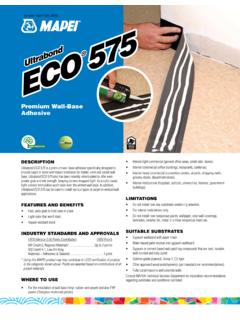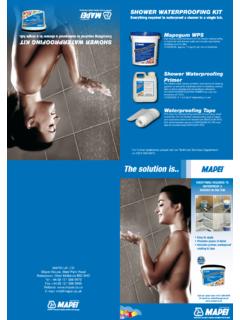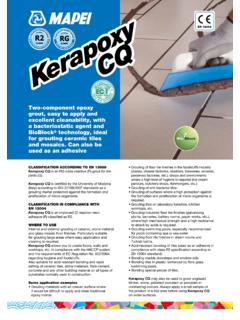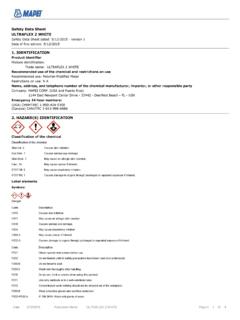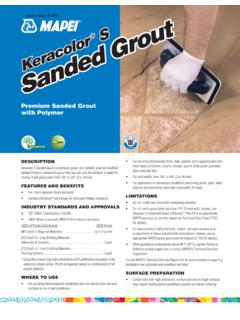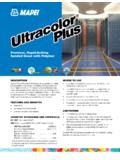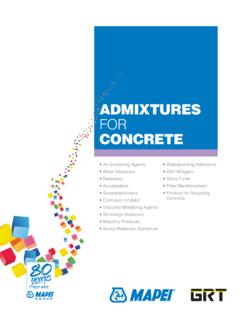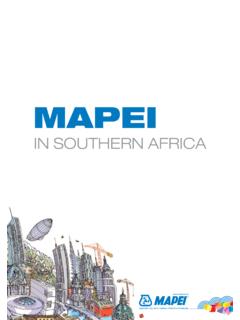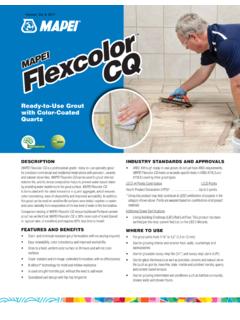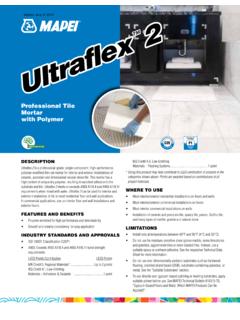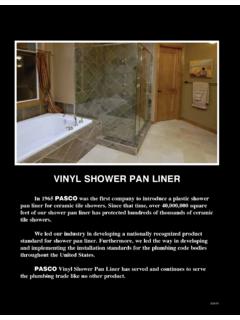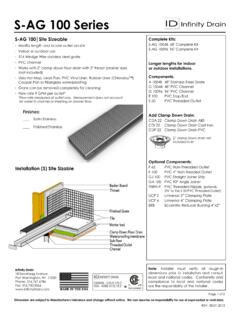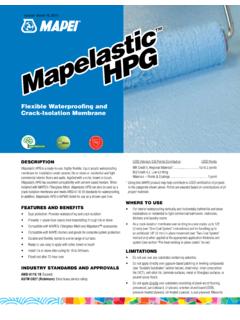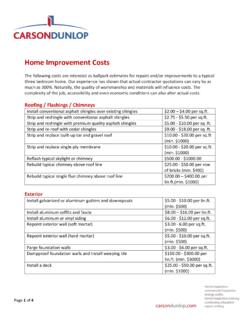Transcription of Premium Waterproofing and Crack-Isolation …
1 DESCRIPTIONM apelastic AquaDefense is a premixed, advanced liquid-rubber, extremely quick-drying Waterproofing and Crack-Isolation membrane for installation under ceramic tile or stone in residential, commercial and industrial environments. Mapelastic AquaDefense provides a thin, continuous barrier to protect adjacent rooms and floors below from water damage. For common problem areas like coves, corners, cracks and drains, it can be combined with MAPEI s optional Reinforcing Fabric or Mapeband accessories (cove roll and drain flash) to provide additional protection.
2 Mapelastic AquaDefense dries after about 30 to 50 minutes and is then ready to receive any MAPEI polymer or epoxy mortar. Mapelastic AquaDefense can be flood-tested after 12 hours of drying time, is IAPMO-listed for use as a shower-pan liner, and exceeds ANSI and ANSI AND BENEFITS Very quick drying: Install tile after 30 to 50 minutes of drying time. Time-saving: Flood-test as shower-pan liner after 12 hours of drying time. Apply with roller or brush easy to install over flat, curved or irregularsurfaces Bonds to a wide range of surfaces; convenient, user-friendly and versatile No odor.
3 Great for confined spaces Prevents in-plane floor cracks from transmitting through tile or stoneINDUSTRY STANDARDS AND APPROVALS ANSI: Exceeds standard ( Waterproofing Membranes for Thin-Set Ceramic Tile) and standard ( Crack-Isolation Membranes for Thin-Set Ceramic Tile) ASTM: C627 (Robinson) service rating for extra heavy ASTM: E-96 Method E, meeting requirements of < perms IAPMO: Listed for use as shower-pan liner IAPMO File #3996 ICC Evaluation Service Report ESR 3474 Los Angeles Board of Building & Safety Commissioners File Number M-13 0 0 2 2 LEED v3 Points Contribution LEED PointsMR Credit 5, Regional Materials*.
4 Up to 2 points IEQ Credit , Low-Emitting Materials Paints & Coatings ..1 point* Using this product may help contribute to LEED certification of projects in thecategories shown above. Points are awarded based on contributions of all project materials. WHERE TO USE Residential and commercial interior/exterior floors, walls and ceilings Industrial interior floors and walls Tub and shower surrounds: bathrooms; kitchens; food prep, dishwashing, servery and cafeteria areas; countertops; and laundry rooms Residential and commercial submerged applications: freshwater pools, fountains and water features (completely covered by ceramic tile) Cantilevered balconies and decks over unoccupied space (see the Limitations section) Balconies and decks over occupied space when used in conjunction with a primary Waterproofing membraneMapelastic AquaDefense AquaDefense Mapelastic Premium Waterproofing and Crack-Isolation MembraneVersion: Oct.
5 10, 2017 Steam rooms and steam showers (refer to TCNA handbook s sections SR613 and SR614 or TTMAC 319SR and 321SR). Meets ASTM E-96 Procedure E for a low perm waterproof membrane In-plane crack isolation up to 1/8" (3 mm) over nonstructural cracks MAPEI's Reinforcing Fabric is available but optional for use on coves, corners and field Mapelastic AquaDefense is not for use over structural cracks, in-plane cracks beyond 1/8" (3 mm) or where vertical out-of-plane movement occurs. Do not use over substrates containing asbestos, dimensionally unstable substrates such as hardwood flooring, particleboard, oriented strand board (OSB), Masonite or metal.
6 See "Suitable Substrates" section below. Do not use over: Plank flooring, treated plywood, Lauan, gypsum-based floor-patching compounds, vinyl, glazed tile, laminate, fiberglass or epoxy floors, or storage tanks. Do not use where excessive substrate moisture and/or where negative hydrostatic pressure exists. Maximum allowable moisture is 8 lbs. per 1,000 sq. ft. (3,63 kg per 92,9 m2) per 24 hours per ASTM F1869 or up to 85% relative humidity as measured with moisture probes. Do not use: As a single-application roof-deck membrane , wear surface or primary Waterproofing membrane on balconies or decks directly over occupied space or in storage tanks; or with premixed setting materials.
7 Do not allow direct contact with solvent-based MAPEI s Technical Services Department for installation recommendations regarding substrates and conditions not SUBSTRATES Interior and exterior Fully cured concrete at least 28 days old (see Limitations section) Masonry walls of cement block or brick Cured cement mortar beds or leveling coats Cement backer units (CBUs)Interior only Gypsum wallboard (walls only, in approved application areas only) Properly prepared radiant-heated substrates Properly prepared unglazed ceramic tile and cement terrazzo floors, and gypsum underlayments with a minimum of 2,500 psi (17,2 MPa) in compressive strength Note: Existing unglazed ceramic tile must be abraded, and existing cement terrazzo must be mechanically profiled.
8 Both must be skimcoated with an appropriate MAPEI latex- or polymer-modified mortar. Exterior-grade plywood (for interior residential floors and countertops in dry areas only) PVC, copper, brass and stainless-steel pipe penetrations (abraded) Tile Council of North America (TCNA) Statement on Deflection Criteria Floor systems, including the framing system and subfloor panels, over which tile will be installed should be in conformance with the IRC [International Residential Code] for residential applications, the IBC [International Building Code] for commercial applications, or applicable building codes.
9 Note: The owner should communicate in writing to the project design professional and general contractor the intended use of the tile installation, in order to enable the project design professional and general contractor to make necessary allowances for the expected live load, concentrated loads, impact loads, and dead loads including the weight of the tile and setting bed. The tile installer shall not be responsible for any floor framing or subfloor installation not compliant with applicable building codes, unless the tile installer or tile contractor designs and installs the floor framing or PREPARATION All recommended substrates must be structurally sound, stable, clean and free of any substance preventing adhesion.
10 Do not use chemicals (acid etching or stripping) to prepare approved substrates. Concrete substrates should have a concrete surface profile of #2 per the International Concrete Repair Institute (ICRI). Mechanically clean and profile by diamond-cup grinding or other engineer-approved method when necessary. Substrate and room temperatures must be 45 F to 95 F (7 C to 35 C) during and at least 24 hours after application. See MAPEI's Surface Preparation Requirements document in the Reference & Installation Guides section of the Tile & Stone Installation Systems page on MAPEI's all appropriate safety equipment before use.
